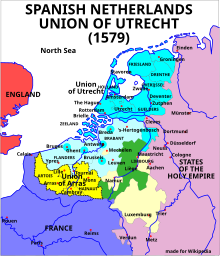Union of Utrecht
This article includes a list of general references, but it lacks sufficient corresponding inline citations. (January 2013) |
The Union of Utrecht (Dutch: Unie van Utrecht) was a treaty signed on 23 January 1579 in Utrecht, the Netherlands, unifying the northern provinces of the Netherlands, until then under the control of Habsburg Spain.
The Union of Utrecht is regarded as the foundation of the Republic of the Seven United Provinces, which was not recognized by the Spanish Empire until the Twelve Years' Truce in 1609.
The treaty was signed on 23 January by Holland, Zeeland, Utrecht (but not all of Utrecht) and the province (but not the city) of Groningen. The treaty was a reaction of the Protestant provinces to the 1579 Union of Arras (Dutch: Unie van Atrecht), in which the southern provinces declared their support for Roman Catholic Spain.
During the following months of 1579, other states signed the treaty as well, such as Ghent, cities from Friesland, as well as three of the quarters of Guelders. In the summer of 1579, Amersfoort from the province of Utrecht also joined, together with Ypres, Antwerp, Breda and Brussels. In February 1580, Lier, Bruges and the surrounding area also signed the Union. The city of Groningen shifted in favor under influence of the stadtholder for Friesland, George van Rennenberg, and also signed the treaty. Later on, Zutphen also signed so Guelders (of which Zutphen is one of the quarters) supported the Union completely. This happened in April 1580, as did the signing of Overijssel and Drenthe.

This leads to a general and simplified overview of the parts that joined:
- the County of Holland
- the County of Zeeland
- the Lordship of Utrecht
- the Duchy of Guelders
- the Lordship of Groningen
- the Lordship of Friesland
- the County of Drenthe
- the Lordship of Overijssel
- the Duchy of Brabant
- the County of Flanders
- the cities of Tournai and Valenciennes
Flanders was almost entirely conquered by the Spanish troops, as was half of Brabant. The United Provinces still recognized Spanish rule after the Union of Utrecht. However, the Union contributed to the deterioration in the relationship between the provinces and their lord, and in 1581 the United Provinces declared their independence of the king in the Act of Abjuration.
The Twelve Years' Truce of 1609 essentially marked the end of the Dutch struggle for independence and a pause in one of history's longest running conflicts, the Eighty Years' War. As Pieter Geyl puts it, the truce marked "an astonishing victory for the Dutch." They gave up no land and did not agree to halt their attacks on Spanish colonies and the Spanish trade empire. In return the Spanish granted the United Provinces de facto independence by describing them as "Free lands, provinces and states against who they make no claim" for the duration of the truce.[1]
See also
References
- ^ Pieter Geyl (1980). The revolt of the Netherlands, 1555-1609. Barnes & Noble Books.
Further reading
- Geyl, Pieter (1980). The revolt of the Netherlands, 1555-1609. Barnes & Noble Books.
- Israel, Jonathan I. The Dutch Republic: Its Rise, Greatness, and Fall 1477-1806 (1998) pp 184-96
- Koenigsberger, H. G. Monarchies, States Generals & Parliaments: The Netherlands in the Fifteenth & Sixteenth Centuries (2002)
- Salmon, Lucy Maynard. The Union of Utrecht (1894) online pp 137-48
